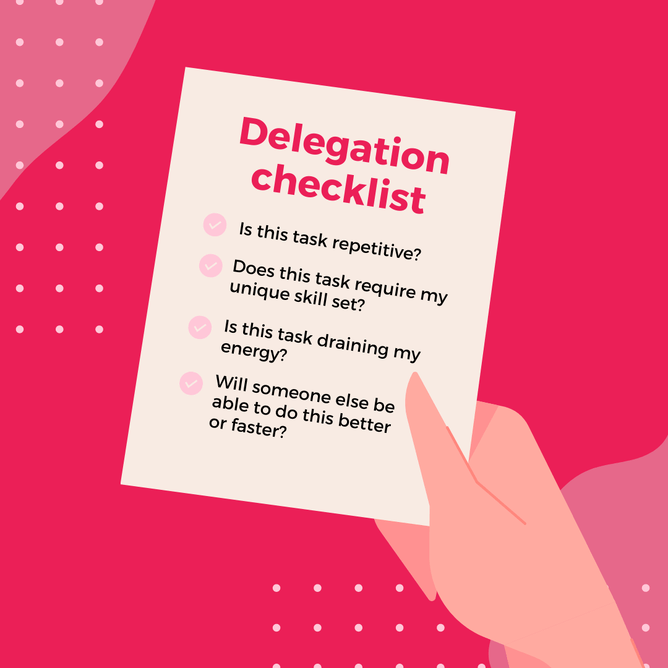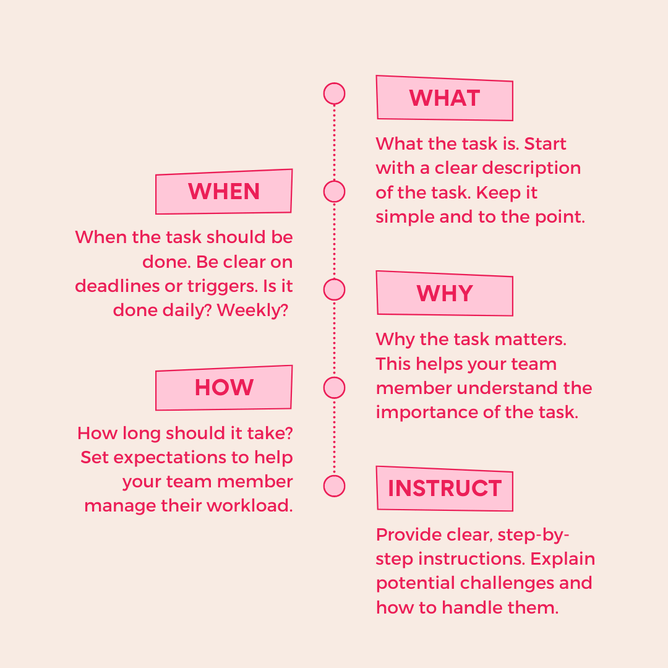As a business owner, you’re probably juggling a million tasks at once—admin, client calls, marketing, finance, product development… the list goes on. It’s easy to get stuck in the weeds, spending your time on tasks that don’t directly drive your business forward.
That’s where delegation comes in.
But if you’re new to delegation, you might be thinking, Where do I even start? How do I know which tasks to hand off? In this blog, we’re breaking down everything you need to know about delegating effectively, so you can free up your time and focus on the high-impact tasks that really grow your business.
Why Delegation is Key to Business Growth
You’ve probably heard the phrase “work on your business, not in it.” It’s a great concept, but without delegation, it’s impossible to achieve.
When you’re doing everything yourself, your growth is limited by your capacity to get things done. But when you delegate, you open up the potential for growth because you’re no longer the bottleneck.
Here’s what effective delegation can help you achieve:
More time for high-impact work: By delegating routine tasks, you free up time to focus on strategic planning, client relationships, and growth opportunities.
Better use of resources: Delegating to people with the right skills means tasks are done more efficiently and effectively.
Reduced burnout: Letting go of tasks that drain your energy means you’re more focused, motivated, and ready to steer your business in the right direction.
Ready to take your first step towards smarter delegation? Here’s how to do it.
Step 1: Identify the Right Tasks to Delegate
The first step in mastering delegation is knowing what to delegate. Not all tasks are suitable for handing off, so it's important to identify the right ones that will free up your time without compromising the quality of your business.
Ask yourself these questions:
Is this task repetitive?
Tasks that you do repeatedly—like sending emails, managing your calendar, or filing documents—are perfect for delegation. These tasks don’t require your expertise and can easily be handed off to a Virtual Assistant or team member.
Does this task require my unique skill set?
If the task requires your expertise, like client strategy or business development, it’s something only you can do. But if it’s an administrative task that anyone can learn, delegate it.
Is this task draining my energy?
If you dread a task, there’s a good chance it’s not the best use of your time. These energy-draining tasks are ideal candidates for delegation.
Will someone else be able to do this better or faster?
Be honest with yourself: Are you holding onto tasks that someone else could do more efficiently? Delegating to someone with expertise in that area not only frees up your time but ensures the task is done right.
Step 2: Choose the Right Tools for Delegation
Once you’ve identified the tasks you want to delegate, the next step is to use the right tools to make the process smooth and efficient. Thanks to technology, delegating is easier than ever.
Here are some helpful tools that can make delegation a breeze:
WhatsApp or Voice Notes: Quick voice messages are great for giving real-time instructions or feedback. They’re fast, personal, and perfect for when you're on the go.
Loom or Berrycast: These tools allow you to record your screen while explaining the steps of a task. This is especially useful for visual learners who benefit from seeing exactly how something is done.
Tango: If you prefer written documentation, Tango is a browser extension that automatically creates step-by-step guides as you perform tasks. Perfect for creating repeatable processes your team can follow.
Zoom or Google Meet: Sometimes, live interaction is the best way to explain complex tasks. Use video calls to screenshare and talk your team through the details.
Step 3: Provide Clear, Concise Instructions
Delegation will only be successful if the person you’re delegating to understands exactly what you need. This is where clear communication comes in. Whether you’re delegating to a VA, an employee, or an external team, they need clarity to do the job well.
Here’s what to include when handing over a task:
What the task is: Start with a clear description of the task. Keep it simple and to the point.
Example: “Manage my inbox daily, sorting emails into ‘Action’, ‘Info’, or ‘Delete’.”
When the task should be done: Be clear on deadlines or triggers. Is this a daily task? Weekly? Do it on-demand?
Example: “Clear the inbox every morning by 10am, flagging urgent items for my attention.”
Why the task matters: Providing context helps the person understand the importance of the task and encourages initiative.
Example: “Clearing my inbox allows me to focus on high-priority items, so it’s crucial this is done first thing.”
How long it should take: This sets expectations and helps your team manage their workload.
Example: “This task should take no longer than 30 minutes per day.”
Step-by-step instructions: Give them a roadmap to follow. If there are any tricky parts, explain potential challenges and how to handle them.
Example: “If an email comes from a client, reply within 24 hours or forward it to me if it’s urgent.”
Step 4: Follow Up, But Don’t Micromanage
Once you’ve delegated a task, it’s important to check in periodically to make sure everything is running smoothly. However, resist the temptation to micromanage—this defeats the purpose of delegation!
Here’s how to balance staying in the loop without hovering:
Set milestones or check-in points: Rather than checking on progress constantly, establish clear checkpoints where your VA or employee can update you on how things are going.
Provide feedback: Let them know what’s working well and where they could improve. Constructive feedback helps them grow in the role and gives you peace of mind that the task is on track.
Trust the process: Remember, delegation is about freeing up your time. If you’re constantly checking in or re-doing tasks, you’re not truly delegating. Trust your team to handle it.
Step 5: Learn to Let Go and Scale
Delegation isn’t a one-time event—it’s an ongoing process. As your business grows, the need for delegation increases. Learning to let go of more tasks is critical to scaling your business without burning out.
Here’s how delegation helps you scale:
You focus on high-impact activities: By letting go of low-level tasks, you can dedicate more time to activities that grow your business, like client acquisition, partnerships, and strategy.
Your team becomes more empowered: Delegating responsibility fosters growth in your team. They become more confident, skilled, and engaged—ultimately benefiting your business.
You achieve better work-life balance: When you delegate effectively, you free yourself from the constant hustle. This gives you more time to focus on yourself, your family, or even taking a well-deserved break.
Conclusion: Delegation is the Secret to Success
At its core, delegation is about freeing you up to do what you do best. It’s about recognising that you don’t have to do everything yourself. When done right, delegation isn’t just a time-saver—it’s a game-changer that allows your business to grow, your team to thrive, and your workload to lighten.
By following this step-by-step guide, you’ll feel more confident in delegating tasks and more in control of your business. So, take a deep breath, let go of the tasks weighing you down, and watch your business soar.
Ready to take the first step? Let’s chat about how a Virtual Assistant can help you delegate effectively and start growing your business.





